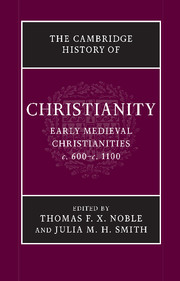Book contents
- Frontmatter
- Introduction: Christendom, c. 600
- Part I Foundations: Peoples, Places, and Traditions
- Part II Christianity in Confrontation
- Part III Christianity in the Social and Political Order
- Part IV Christianity as Lived Experience
- Part V Christianity: Books and Ideas
- 24 Visions of God
- 25 Orthodoxy and deviance
- 26 Making sense of the Bible
- 27 The Christian book in medieval Byzantium
- 28 Saints and their cults
- 29 Last Things
- Conclusion: Christendom, c. 1100
- Bibliographies
- Index
- References
29 - Last Things
from Part V - Christianity: Books and Ideas
Published online by Cambridge University Press: 28 March 2010
- Frontmatter
- Introduction: Christendom, c. 600
- Part I Foundations: Peoples, Places, and Traditions
- Part II Christianity in Confrontation
- Part III Christianity in the Social and Political Order
- Part IV Christianity as Lived Experience
- Part V Christianity: Books and Ideas
- 24 Visions of God
- 25 Orthodoxy and deviance
- 26 Making sense of the Bible
- 27 The Christian book in medieval Byzantium
- 28 Saints and their cults
- 29 Last Things
- Conclusion: Christendom, c. 1100
- Bibliographies
- Index
- References
Summary
Bound to Colum, while I speak,
may the bright one guard me in the seven heavens.
When I go to the road of fear,
I’m not lordless: I have strength.
Early medieval Christians faced the Last Thing s– death and judgement; heaven, hell, and the places in between; the Second Coming and the Last Judgement – with mingled hope and dread. These verses by a seventh-century Irish monk capture both. Like countless Christians after him, Beccán derived particular consolation from trust in a powerful heavenly patron– in his case, St.Columba. His expectations regarding the Last Things, while expressed personally, drew on a stock of otherworld images and ideas which circulated throughout Christendom, transmitted by texts of universal appeal such as the Apocalypse of Paul and the Dialogues of Gregory the Great (d.604). Christians worldwide began the early medieval Period bound together in a common eschatological culture (from Greek eschatos, “last”). But Gregory the Great would be the last universal Christian author, read and respected throughout Christendom. By 1100, definite divergences in eschatological expectation had emerged among the European, Near Eastern, and Asian Christendoms. Attitudes toward the afterlife, the nature of the other word, the final destiny of human kingdoms at the end of time, and the coming Kingdom of God, were shaped profoundly by lived experience of earthly authority. The post-Roman societies of the early medieval West, the continuing eastern Roman Empire in Byzantium, and Christians living in the non-Christian kingdoms of the Near and Far East, began to perceive the otherworld, constructed largely in the image of this world, very differently. This parting of the eschatological ways was, however, a long, gradual process.
- Type
- Chapter
- Information
- The Cambridge History of Christianity , pp. 606 - 624Publisher: Cambridge University PressPrint publication year: 2008
References
- 6
- Cited by



